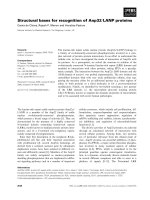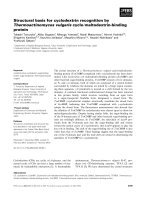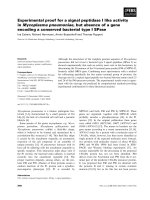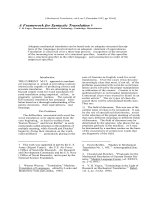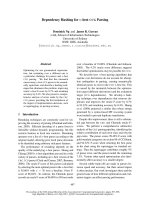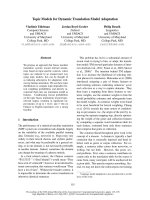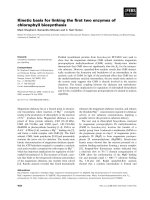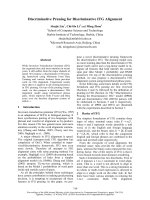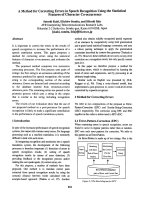Báo cáo khoa học: "Computer Backup for Field Work in Phonology" pdf
Bạn đang xem bản rút gọn của tài liệu. Xem và tải ngay bản đầy đủ của tài liệu tại đây (125 KB, 2 trang )
[Mechanical Translation and Computational Linguistics, vol.11, nos.1 and 2, March and June 1968]
Computer Backup for Field Work in Phonology
by Joseph E. Grimes, John R. Alsop, and Alan Wares, Summer Institute of Linguistics
In the study of a previously unrecorded language, a taxonomy of the
sound system is the most useful starting point for developing the phono-
logical component of a grammar. If the linguist makes at least tentative
assumptions about segmentation and fixes the limits of supposedly relevant
contexts, a computer can approximate this taxonomy. A program by Alsop
reduces a concordance of phonetic segments in their contexts to a series
of taxonomic statements about phoneme distribution by applying Bloch's
criteria for contrast within limited contexts. When applied to data on
Paipai, a Yuman language of the Colorado delta, collected by Wares on a
survey trip, the program found contrast between segments Wares had
identified as allophones in two parallel consonantal series, indicating a
distinction of presumably low functional load with morphophonemic
implications.
There was a time when phonological analysis was
thought of primarily as a data-processing operation to
be performed on strings of symbols in a phonetic trans-
cription. The symbols were classified with reference to
their environments, and the resulting taxonomy was an
end in itself.
One of the reasons this approach foundered was that
no linguist is a sufficiently good phonetician to make it
work consistently. The strings of phonetic symbols have
to be completely correct. On the other hand, evidence
from instrumental phonetics and theoretical backing
from generative grammar suggest that even a good
phonetic transcription will not necessarily guarantee a
complete phonological analysis. There is also plenty of
field experience that indicates that a self-correcting ap-
proach to field work can give the desired analysis readily,
even though one starts with only reasonable phonetic
ability. The first author explains such an approach in
detail in a text on phonological analysis [1].
A second defect in phonology from phonetic transcrip-
tion was its tendency to regard the sounds of speech as
a unilinear sequence of segments. Junctures were put
into the stream of speech by some linguists, and intona-
tional change points were added; but the characteristic
groupings of sounds in syllables, feet, and contours were
regarded more as a nuisance than as part of a model of
phonology.
There was also some fuzziness about the difference
between investigating relationships among sounds for
their own sake and relating sounds to the rest of lan-
guage. There was something especially fitting about
describing the phonology of a language with as little
reference as possible to the way that phonology func-
tioned in communication as a system for realizing the
output of the grammar.
Although the phonology of the 1950s had its prob-
lems, it would be foolish to discount it as all bad. For
field work, in which we include the process of validating
the results of introspection about one's own language as
well as that of validating observations about someone
else's language, it provided the plan for an essential step
that a modern linguist skips only at the risk of basing his
generalizations on nothing but an ad hoc subset of a
language that is convenient for him.
Even though a phonological taxonomy is no longer by
itself a final goal in linguistic analysis, a linguist who tries
to study the phonology of a language without first mak-
ing a good taxonomy stands as much chance of success
as a burglar who makes a robbery without first casing
the joint to see what he is up against. There are times
when this preliminary investigation can be aided mate-
rially by the use of a computer.
Normally we advocate working out a phonological
taxonomy by hand. For the average language studied in
the field, over 85 percent of the taxonomy can be pinned
down in this way in a couple of weeks, while under the
same circumstances it would take at least that long to
get things ready for a computer. Furthermore, effective
field procedures make maximal use of phonological
grouping phenomena; and these are much more difficult
to cope with in an algorithm than are unilinear symbol
strings. The possibility of getting a really comprehensive
analysis of the sounds people make when they talk is at
present, then, greater if the computer is left out of the
picture.
There are, however, three cases where a computer can
contribute to making phonological taxonomies. The first
is in simulating gibberish that is phonologically legal.
One attempts to validate a taxonomy under what
amounts to a random input from grammar. The second
is in going over data that were collected under condi-
tions that did not permit systematic, thoroughgoing ex-
amination of phonology, as, for example, in the linguistic
survey of an unknown area. The third is in endeavoring
73
to reinterpret linguistic material that was collected under
the old assumption that a good phonetic transcription
was the most scientific way to handle linguistic data.
The first case, random derivation of phonetic specifica-
tions, can readily be accomplished by the sort of pro-
grams that are already in use for simulating grammatical
derivations [2]. The second kind of computation, which
would also work for the third, or reanalysis of older
phonetically oriented materials, was implemented by
our group and tested on field survey materials with
interesting results.
To begin with, some simplifying assumptions were
made. Phonetic data were treated as a linear string by
simply ignoring their very real grouping properties. Fur-
thermore, the environment that was considered relevant
for classifying sounds was arbitrarily limited to one seg-
ment before and one segment after the segment in focus.
This bypassed the problem raised by Noam Chomsky
about how much environment is needed to classify
sounds [3] and permitted the use of Bloch's logical
criteria for contrast [4]. By these criteria, pairs of sounds
are said to fluctuate freely if any environment of one is
also an environment of the other; they are in comple-
mentary distribution if no environment of one is also an
environment of the other; and they are in contrast if
some environments of one are also environments of the
other but some are not. In computing terms, this involves
testing the left and right neighbors of pairs of sounds.
If the set on each side of one has identical membership
with the corresponding set on the same side of the other,
the sounds are reported to be in free fluctuation. If the
set of neighbors of one sound on one side has no mem-
bers in common with that of the other sound on the
same side, the sounds are reported to be in complemen-
tary distribution. In any other case they are reported to be
in contrast. Contrast implies a strong expectation that the
difference between the sounds would somewhere in the
language have to be taken into account in distinguishing
underlying representations of formatives. Free fluctua-
tion and complementation both imply a strong expecta-
tion that the phonetic difference is attributable to con-
text. The program was implemented by Alsop in SPS II
assembly language on the IBM 1620 at the University of
Oklahoma and at the Instituto Politécnico Nacional de
Mexico.
Wares had previously made a survey of indigenous
groups that speak Yuman languages in Lower California
and around the Colorado River delta. His list of around
600 words collected in Paipai was prepared for process-
ing. Phonetic symbols were transliterated into strings in
the computer character set and recognized by table
lookup.
The most interesting result of the computer analysis
of Wares's data was the phonological separation of velar
and back velar stops and fricatives. Wares had noted
phonetic k and ķ, x and ҳ in his transcription. He had
thought, however, on examining his data under the pres-
sure of survey conditions, that the back velars occurred
only adjacent to o and a, while the others never did. The
program showed that both pairs were independently in
contrast. In addition, it showed that the nonsyllabic
voiceless vocoid h was in free fluctuation with the velar
fricative, as in xupá 'four,' hupá 'four.'
The program also gave evidence for a suspected con-
trast between apical s and retroflex s, as in saķ 'leaf and
şák 'to whip.' Between the voiced bilabial stop b and the
corresponding fricative β, it corroborated the comple-
mentation that Wares had found.
Because the program did not react to hierarchical
sound patterns like syllables and feet, patterns of stress
and of vowel length did not show up in the results. The
program treated long and short vowels as though they
fluctuated freely, for example. It did not recognize mini-
mal pairs like ñá 'path, road,' which is short, and ñá·
'sun,' which is long; and yú 'eye,' which is short, and yú·
'owl,' which is long.
A change in the pattern-recognizing approach is being
considered to segregate phones at particular positions in
syllables, syllables in feet, and feet in contours. The
intermediate storage of what amounted to a phone con-
cordance of the data was a major problem on the 1620;
with larger machines a list structure for the right- and
left-neighbor sets of each phone should prove easier to
work with.
Received May 10, 1969
References
1. Grimes, Joseph E. Phonological Analysis. Mexico City:
Summer Institute of Linguistics, 1969.
2. Bobrow, Daniel G., and Fraser, J. Bruce. "A Phonological
Rule Tester." Communications of the ACM, vol. 11 (No-
vember 1968).
3. Chomsky, Noam. "The Logical Basis of Linguistic The-
ory." In Proceedings of the Ninth International Congress
of Linguists, edited by Horace G. Lunt. The Hague:
Mouton & Co., 1964.
4. Bloch, Bernard. "Contrast." Language, vol. 29 (January
1953).
74 GRIMES, ALSOP, AND WARES

